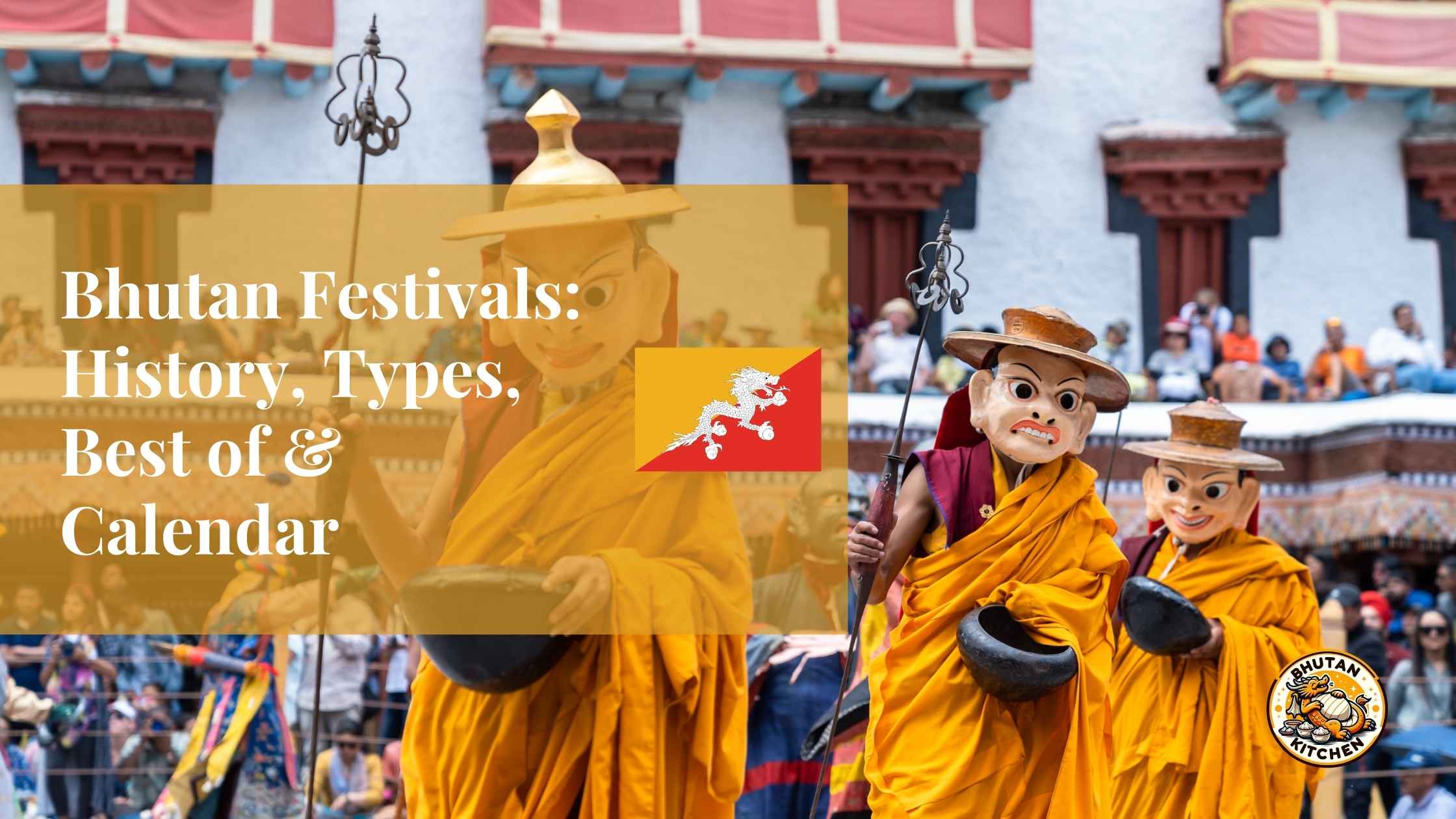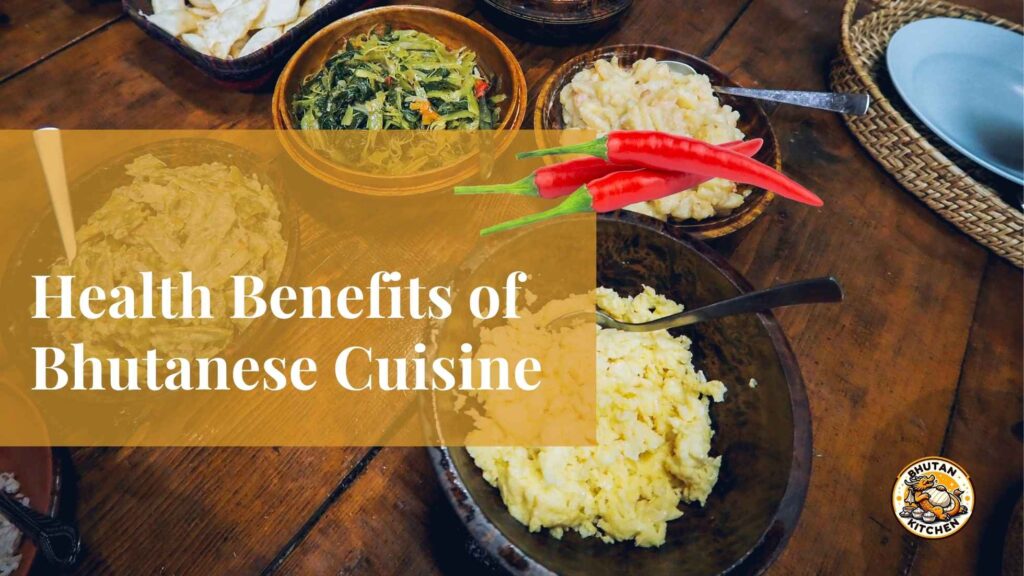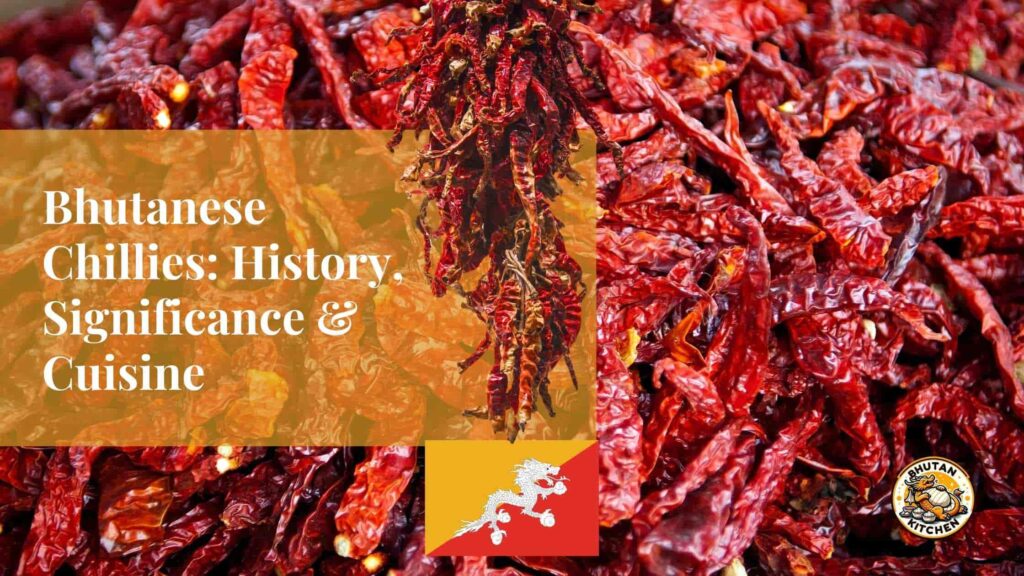Hidden in the Eastern Himalayas, Bhutan, known as the Land of the Thunder Dragon, is a small kingdom that has carefully preserved its rich cultural heritage while embracing controlled modernization. This Buddhist nation, famous for its philosophy of Gross National Happiness, showcases its vibrant traditions most prominently through its festivals, which serve as living museums of its cultural and spiritual heritage.
This comprehensive guide explores Bhutan’s fascinating festival traditions, from their historical origins to practical travel advice. We’ll cover:
- The impact of festivals on Bhutan’s culture and economy
- The historical and cultural significance of Bhutanese festivals
- Types of major festivals and their unique characteristics
- A complete calendar of celebrations
- Essential visitor information, including what to wear and expect
Historical Origins and Significance
Bhutanese festivals, particularly the Tshechus, have been integral to the nation’s cultural fabric since the 8th century. These celebrations originated when Guru Padmasambhava, also known as Guru Rinpoche, introduced Buddhism to Bhutan. Padmasambhava first visited Tibet and Bhutan in the 8th and 9th centuries. His arrival in Bhutan was specifically to aid the dying king Sindhu Raja. In the Bumthang Valley, Padmasambhava performed a series of dances to restore the king’s health. The grateful king subsequently helped spread Buddhism in Bhutan.
The first tshechu was organized by Padmasambhava in Bumthang, where he presented his eight manifestations through eight forms of dances. These became the foundation for the Cham dances that continue to depict his glory. During his mission, Padmasambhava would convert opponents of Buddhism through a specific process – performing rites, reciting mantras, and finally executing a dance of subjugation to conquer local spirits and gods.
Initially serving as vehicles for Buddhist teachings through dance, music, and ritual, these festivals evolved to become crucial community events that strengthen social bonds while preserving cultural traditions. The performances, known as cham dances, were designed to make Buddhist teachings accessible to the general population through visual storytelling.
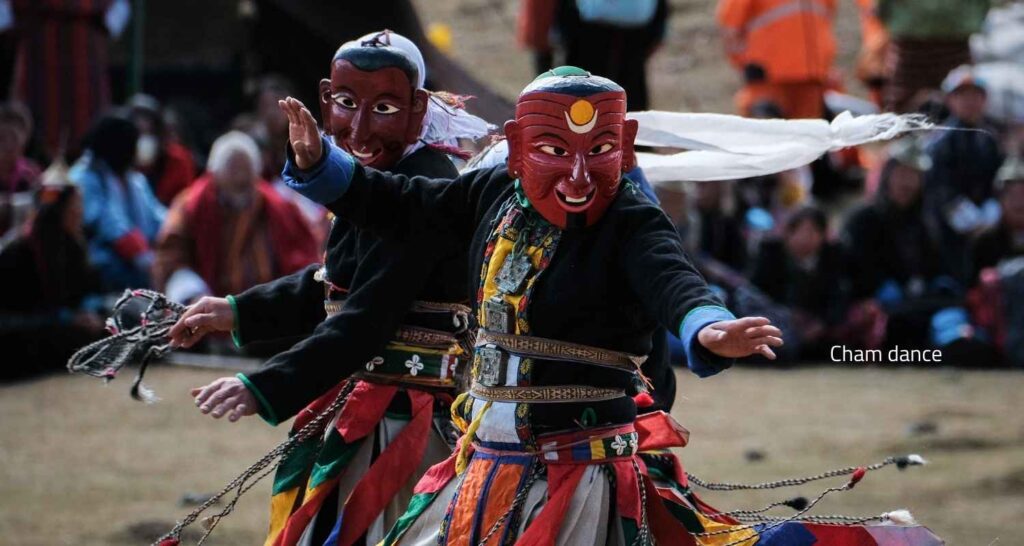
3 Types of Major Bhutanese Festivals
Bhutan hosts over 150 annual festivals that celebrate its rich cultural and spiritual heritage. These festivals not only bring communities together but also showcase the country’s unique traditions.
Tshechus
Tshechus hold a significant place in Bhutan’s festival calendar, occurring annually in different districts. A Tshechu is specifically held on the tenth day of a month according to the lunar Tibetan calendar, though the exact month varies by location. These are religious festivals of the Drukpa Lineage of the Kagyu school of Tibetan Buddhism.
The central feature of Tshechus are the Cham dances – costumed, masked performances that present moral stories, particularly ones based on the life of the 9th century Nyingma teacher Padmasambhava. Both monks (performing unmasked) and laypeople (performing masked) participate in different dances.
A significant ritual during most Tshechus is the unfurling of a thongdrel – a large appliqué thangka typically showing Padmasambhava surrounded by holy beings. This sacred artwork is displayed before dawn and is believed to cleanse viewers of sin.
Ura Yakchoe
Ura Yakchoe is a significant festival celebrated in the Ura Valley of Bumthang. Originally rooted in bonism as a celebration to appease the god of yak before Buddhism’s arrival in the 18th century, the festival has evolved while maintaining its name. Today, it is primarily celebrated in honor of a statue of Chador, a manifestation of Vajrapani, which according to legend was a gift from Guru Rinpoche to the Ura people.
The five-day festival centers around a sacred treasure (Chagdhor Toen) that is brought from Gaden Temple to Ura Temple on the first day, led by Gaden Gathpo. Each subsequent day features distinct ceremonial performances including Shinji Phomo, Dramitse Ngachham, Draleypangtey, Shazam, and concludes with Thongdroel and Yedam wang. The statue is brought to bless the community and festival attendees, with its arrival being surrounded by an air of mystery but celebrated with deep faith and devotion.
The festival takes place in spring (specifically in April) in Ura-Dozhi, Ura Gewog, Bumthang, combining spiritual significance with cultural performances that showcase Bhutan’s rich heritage.
Regional Festivals
In addition to Tshechus and Ura Yakchoe, Bhutan offers diverse regional festivals that reflect unique local traditions and customs. Each region has its own distinct celebrations, often linked to historical events or agricultural milestones. These localized festivals contribute to the preservation of cultural identity while fostering community spirit. Examples include the Jampa Lhakhang Drubchen in Bumthang and the Wangdue Phodrang Tshechu, both of which draw significant participation. By highlighting regional diversity, these festivals strengthen the cultural fabric of Bhutan, encouraging both locals and visitors to connect with the country’s rich traditions.
Bhutan’s Top 5 festivals
Bhutan hosts numerous festivals, each showcasing unique traditions and cultural significance. Here are five of the most prominent festivals in Bhutan.
1. Thimphu Tshechu
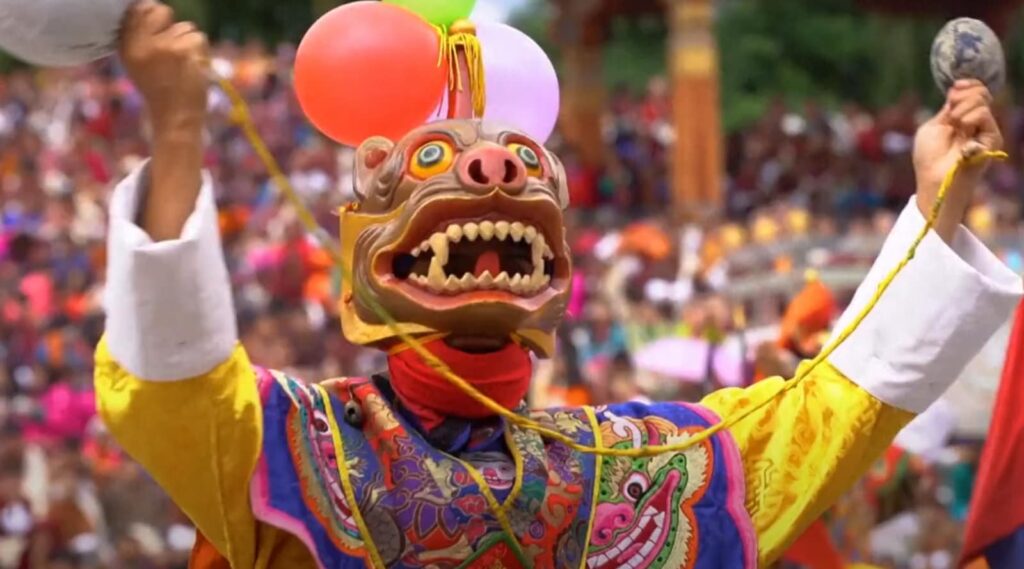
Thimphu Tshechu occurs over three days in Tashichho Dzong, celebrating Guru Rinpoche, a revered figure in Buddhism. Attendees witness colorful masked dances, including the popular “Dance of the Fearless,” performed by monks. This festival attracts thousands each year, fostering community spirit and showcasing vibrant traditional attire.
- Location: Tashichho Dzong
- Duration: Three days
- Highlights: Colorful masked dances including the “Dance of the Fearless”
- Significance: One of the largest festivals attracting thousands
2. Jambay Lhakhang Drup
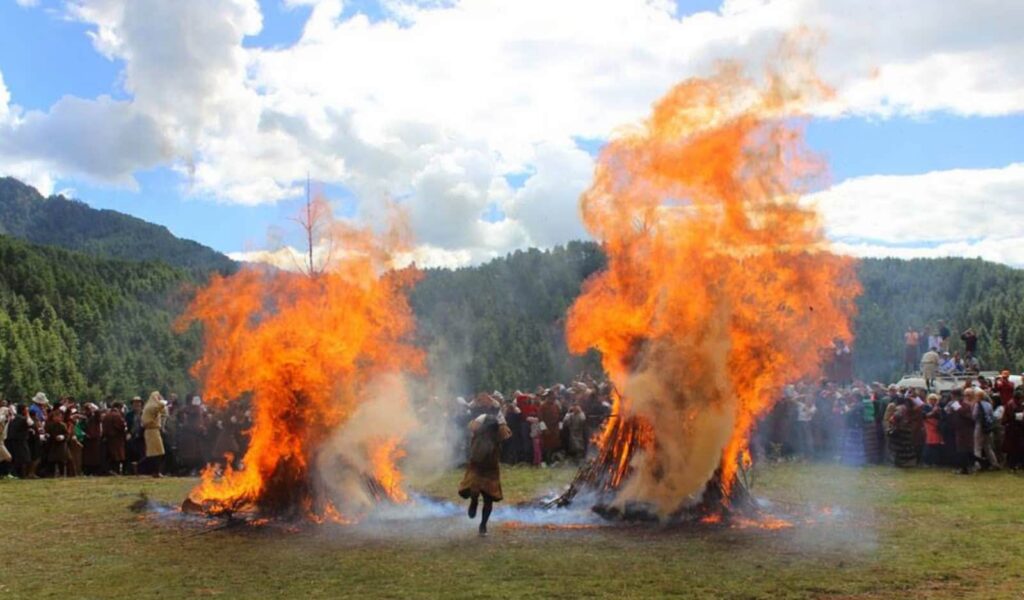
Jambay Lhakhang Drup takes place in Bumthang to honor the founding of a sacred temple. The festival features unique rituals, including the fire blessing ceremony called “Mewang,” where sacred flames bless participants. Expect lively performances, showcasing traditional masked dances that highlight regional culture and heritage.
- Location: Bumthang
- Special Feature: Fire blessing ceremony (Mewang)
- Cultural Elements: Unique rituals and traditional performances
- Significance: Honors the founding of a sacred temple
3. Wangdue Phodrang Tshechu
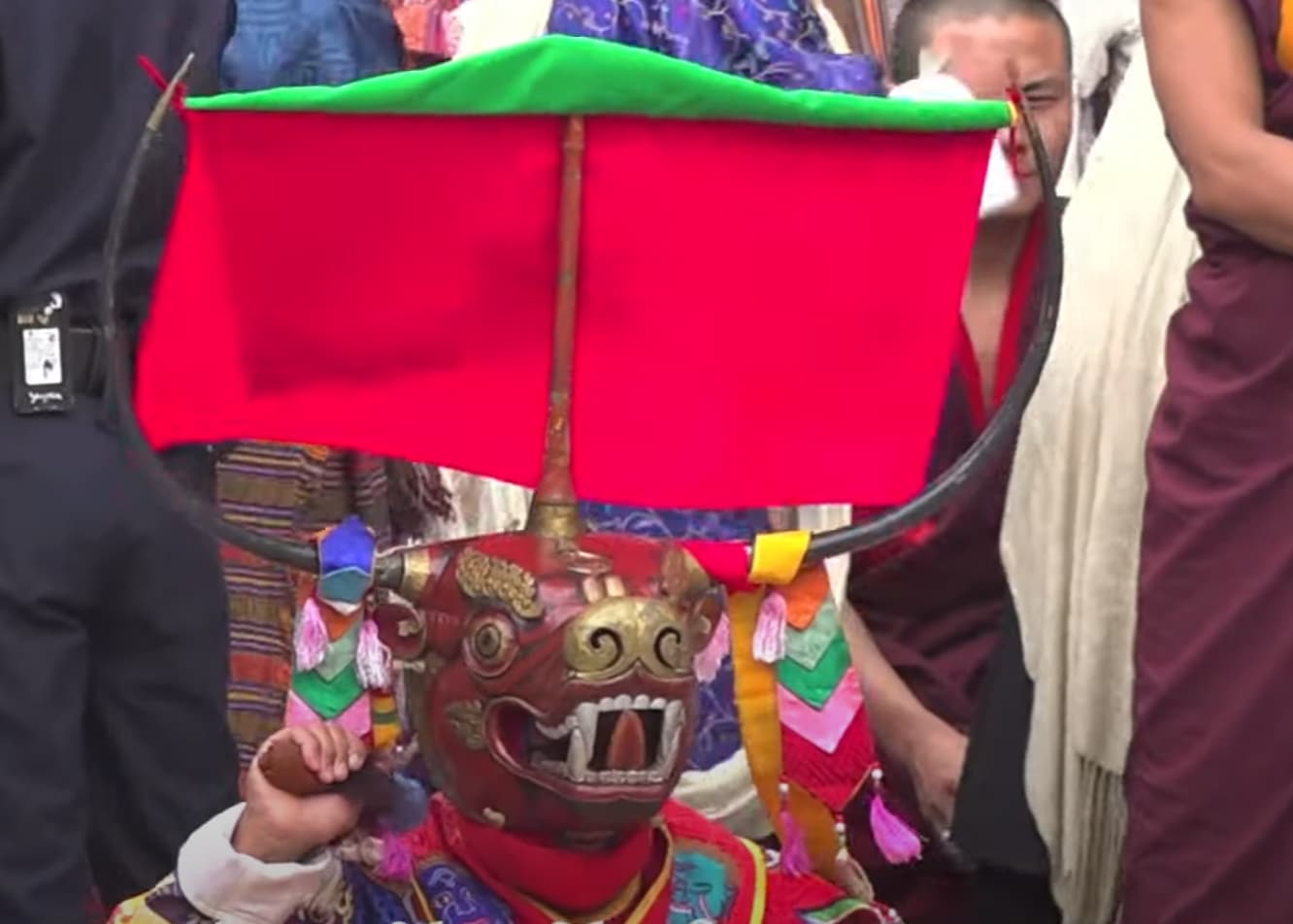
Wangdue Phodrang Tshechu celebrates local legends and culture, typically held in autumn. This festival features the captivating “Dance of the Ox,” representing strength and resilience. You’ll find colorful displays and vibrant traditional performances that offer a glimpse into the local community’s values and stories.
- Highlight: “Dance of the Ox”
- Cultural Value: Celebrates local legends
- Artistic Elements: Vibrant traditional performances
- Community Aspect: Strong representation of local values and stories
4. Punakha Drubchen
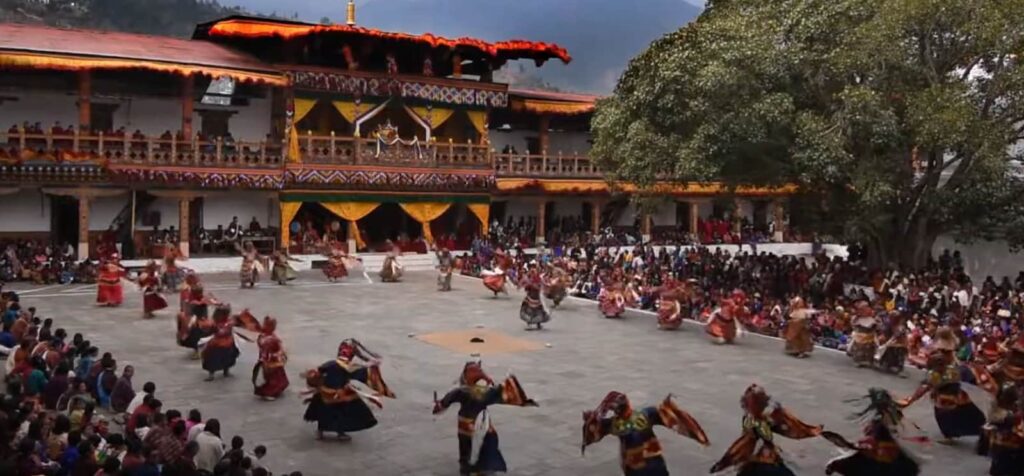
Punakha Drubchen honors Bhutan’s spiritual heritage and commemorates significant historical events. The festival includes captivating performances, such as the “Dance of the Four Harmonious Friends.” Engaging with locals provides insight into their traditions while enjoying a dynamic atmosphere filled with music and dance.
- Focus: Commemorates historical events
- Highlight: “Dance of the Four Harmonious Friends”
- Unique Aspect: Combines spiritual heritage with historical reenactments
- Community Impact: Strong local participation
5. Paro Tshechu
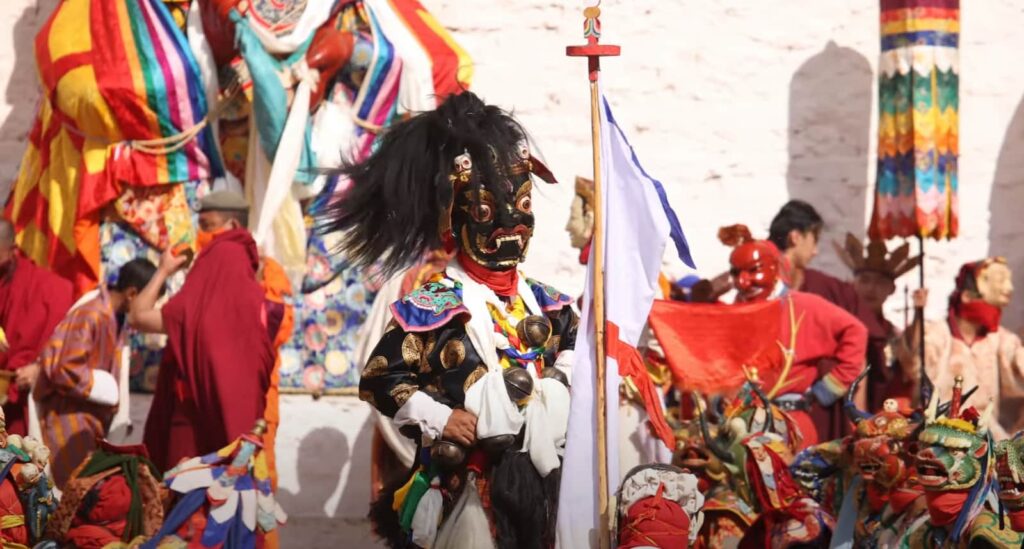
Paro Tshechu, one of Bhutan’s most popular festivals, takes place in the spring. During this event, expect grand processions and impressive masked dances. Notable highlights include the display of the giant Thongdrel, a large tapestry unveiled at dawn. This tapestry symbolizes significant teachings and brings the community together in celebration.
- Time: Spring
- Key Feature: Display of the giant Thongdrel at dawn
- Special Elements: Grand processions and impressive masked dances
- Cultural Importance: Major spiritual and social gathering
Calendar of 31 Bhutanese festivals by Month
Here’s a comprehensive calendar of Bhutan’s festivals for 2025, providing insight into when and where to experience these culturally vibrant events. Each festival showcases unique traditions and communal spirit.
| Month | Festival Name | Dates | Description | Highlights |
|---|---|---|---|---|
| February | Punakha Drubchen | February 16-18 | Reenacts the 17th-century victory over Tibet | Historical reenactment, military ceremonies, traditional costumes |
| February | Punakha Tshechu | February 20-22 | Features lively performances and local delicacies | Masked dances, traditional performances, local food stalls |
| February | Tharpaling Thongdrol | February 22-24 | Unfurling of a large thangka with spiritual rituals | Sacred thangka display, religious ceremonies, community prayers |
| February | Thangbi Mani | February 28 | Includes a fire blessing ceremony for community well-being | Fire blessing ritual, communal gatherings, traditional offerings |
| March | Zhemgang Tshechu | March 5-7 | Honors Guru Padmasambhava with traditional dances | Masked dances, spiritual ceremonies, local customs |
| March | Gasa Tshechu | March 10-12 | Showcases local customs and community prayers | Regional traditions, prayer ceremonies, community gatherings |
| March | Talo Tshechu | March 15-17 | Known for its serene atmosphere and spiritual significance | Spiritual ceremonies, peaceful setting, traditional performances |
| March | Gomphukora | March 20-21 | Honors sacred relics with traditional dances | Sacred relic ceremonies, traditional dances, religious rituals |
| March | Paro Tshechu | March 25-28 | Renowned for the Thongdrol ceremony and vibrant performances | Giant Thongdrel display, grand processions, masked dances |
| April | Chhorten Kora | April 1-3 | Significant pilgrimage with prayers and rituals | Pilgrimage ceremonies, prayer sessions, religious offerings |
| April | Rhododendron Festival | April 5-7 | Celebrates biodiversity through nature walks and local art | Nature walks, art exhibitions, cultural displays |
| April | Domkhar Tshechu | April 10-12 | Celebrates local deities with traditional dances | Deity honoring ceremonies, traditional dances, local customs |
| April | Ura Yakchoe | April 17-19 | Centers around a sacred relic with performances | Sacred relic blessings, performances, community celebrations |
| June | Nimalung Tshechu | June 1-3 | Honors Guru Rinpoche with masked dances and prayers | Guru Rinpoche celebrations, masked dances, prayer ceremonies |
| June | Kurjey Tshechu | June 6-8 | Commemorates Guru Rinpoche’s teachings with dances | Sacred site festivities, traditional dances, religious ceremonies |
| July | Haa Summer Festival | July 15-18 | Showcases nomadic lifestyle with archery and handicrafts | Nomadic culture displays, archery competitions, handicraft exhibitions |
| August | Tsho Chenpo | August 8-10 | Celebrates the local community through traditional practices | Community celebrations, traditional customs, local practices |
| September | Tour of the Dragon | September 15 | Mountain bike race promoting Bhutan as an adventurous hub | Mountain biking event, adventure sports, cultural exchange |
| September | Thimphu Drubchen | September 22-24 | Precursor to the grand Thimphu Tshechu with rituals | Pre-Tshechu rituals, religious ceremonies, traditional preparations |
| September | Wangdue Tshechu | September 28-30 | Highlights cultural festivities in Wangdue Phodrang | Regional celebrations, cultural performances, traditional customs |
| October | Jakar Tshechu | October 3-5 | Celebrates Guru Rinpoche with masked dances and prayers | Masked dances, prayer ceremonies, religious celebrations |
| October | Chhukha Tshechu | October 10-12 | Honors Bhutanese values through traditional performances | Cultural displays, traditional performances, value celebrations |
| October | Jhomolhari Mountain Festival | October 15-17 | Showcases high-altitude culture and conservation efforts | Highland culture, conservation awareness, traditional sports |
| October | Prakhar Duchhoed | October 20-22 | Commemorates Pema Lingpa’s life with ritual ceremonies | Ritual ceremonies, historical commemorations, spiritual gatherings |
| November | Royal Highland Festival | November 5-7 | Celebrates highland culture and local customs | Highland traditions, cultural displays, community gatherings |
| November | Dechenphu Tshechu | November 10-12 | Marks spiritual celebrations honoring Guru Rinpoche | Spiritual ceremonies, traditional dances, religious observances |
| November | Mongar Tshechu | November 15-17 | Showcases the cultural vibrancy of the Mongar district | Regional traditions, cultural performances, community celebrations |
| December | Lhuentse Tshechu | December 5-7 | Features vibrant dances honoring Guru Padmasambhava | Traditional dances, spiritual ceremonies, religious observances |
| December | Trongsa Tshechu | December 10-12 | Showcases elaborate dances representing Bhutan’s identity | Cultural performances, national identity celebrations, traditional dances |
| December | Druk Wangyel Tshechu | December 15-17 | Celebrates contributions of the King and armed forces | Military ceremonies, royal celebrations, national pride events |
| December | Samdrupjongkhar Tshechu | December 20-22 | Highlights eastern region’s cultural richness through performances | Eastern traditions, cultural performances, regional customs |
Best Times to Visit a Bhutanese Festival
Spring and autumn present ideal weather, characterized by moderate temperatures and clear skies, making these seasons popular for attending festivals.
Spring (March-May)
- Ideal weather conditions: 60-70°F (15-21°C)
- Clear skies
- Major festivals like Paro and Thimphu Tshechus
- Perfect for outdoor celebrations
Autumn (September-November)
- Comfortable temperatures: 55-65°F (13-18°C)
- Clear mountain views
- Important festivals like Thimphu Drubchen
- Peak tourist season
Other Seasons
- Summer/Monsoon (June-August): Some festivals continue despite rain but is something to consider on your travels.
- Winter (December-February): Fewer but unique celebrations in cooler weather
Planning Your Visit
To make the most of your festival experience:
- Book accommodations well in advance
- Check festival dates (they follow the 10th day of the lunar calendar)
- Respect local customs and dress codes
- Bring appropriate clothing for weather conditions
- Consider hiring a local guide
Festival Planning Tips:
- Dates may shift by 2-4 weeks each year due to the lunar calendar
- Popular festivals like Thimphu and Paro Tshechus require advance booking
- Some remote festivals may require special permits
- Consider combining multiple festivals in the same region
- Check weather conditions for specific months before planning
- Check if you like the Food.
What is the Food like at Festivals in Bhutan?
Food plays a central role in Bhutanese festivals, offering unique culinary experiences that enhance the celebratory atmosphere. Traditional dishes, particularly local favourites, are integral to these occasions. Each festival features an array of food options, showcasing the rich flavours of Bhutan using locally sourced ingredients.
Distinctive regional foods are often prepared during festivals. For example, Ema Datshi, a spicy dish made with chili peppers and cheese, is a staple at many events. Additionally, Phaksha Paa, a savoury pork stir-fry with radish and spices, adds to the festive spread. Jasha Maru, a flavourful chicken curry, delights many attendees as well.
Celebrations also include various stews, such as rich meat stews made with mountain herbs. These hearty dishes symbolize the warmth of hospitality in Bhutanese culture. Snacks, including momo (dumplings) and zowd (rice snacks), are popular among festival-goers, providing quick bites throughout the day.
Bhutanese Festivals and their Impact on Tourism and the Economy
These vibrant celebrations not only preserve age-old traditions but also significantly boost local economies. As you immerse yourself in the colourful performances and unique culinary delights, you’re contributing to a thriving tourism industry that supports artisans and vendors.
Impact on Tourism and Economy:
- Tourism in particular the Sustainable Development Fee (SDF) contributes around US$ 88.6 million to GDP
- Festivals Employ 21,000 people directly and indirectly
- Benefits rural communities through transport, portage and handicraft promotion
- Supports increasing number of local entrepreneurs
- Serves as the second largest revenue generator after hydropower
Conclusion
Bhutanese festivals offer more than just spectacular performances—they provide a window into the soul of this unique Himalayan kingdom. Whether you’re witnessing the unfurling of a massive thangka at dawn or joining in community festivities, these celebrations offer unforgettable experiences that combine spiritual devotion with cultural preservation and community joy. At Bhutan Kitchen, we look to bring you some of this festive spirit and community in the form of our Food, why not check out our menu and enjoy the flavour of Bhutan.

